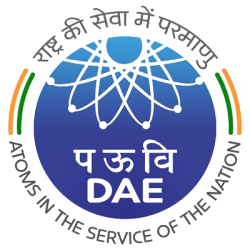Department of Atomic Energy
| Paramāṇu Ūrjā Vibhāga | |
 Logo of DAE Motto: Atoms in the Service of the Nation | |
| Department overview | |
|---|---|
| Formed | 3 August 1954 |
| Jurisdiction | India |
| Headquarters | Mumbai, Maharashtra, India[1] |
| Annual budget | ₹18,264.89 crore (US$2.6 billion)[2] |
| Minister responsible |
|
| Deputy Minister responsible |
|
| Department executive |
|
| Parent Department | Prime Minister's Office |
| Child agencies |
|
| Website | www |
Politics of India |
|---|
 |
|
The Department of Atomic Energy (DAE) (IAST: Paramāṇu Ūrjā Vibhāga) is a department under the Prime Minister of India with headquarters in Mumbai, Maharashtra, India.[3] DAE was established in 1954 by a Presidential Order. DAE has been engaged in the development of nuclear power technology, applications of radiation technologies in the fields of agriculture, medicine, industry and basic research. DAE comprises five research centres, three industrial organisations, five public sector undertakings and three service organisations. It has under its aegis two boards for promoting and funding extramural research in nuclear and allied fields, mathematics and a national institute (deemed university). It also supports eight institutes of international repute engaged in research in basic sciences, astronomy, astrophysics, cancer research and education. It also has in its fold an educational society that provides educational facilities for children of DAE employees. The important programmes of the DAE are directed towards:
- Enhancing the share of nuclear power in the Power Sector by deployment of indigenous and other proven technologies, and to develop fast breeder reactors, as well as thorium-based reactors with associated fuel cycle facilities;
- Building and operating of research reactors for the production of radioisotopes, building other sources of radiation such as accelerators and lasers, and developing and deploying radiation technology applications in the fields of medicine, agriculture, industry and basic research.
- Developing advanced technologies such as accelerators, lasers, supercomputers, robotics, areas related to fusion research, strategic materials and instrumentation, and encouraging the transfer of technology to industry.
- Carrying out and supporting basic research in nuclear energy and related frontier areas of science; interaction with universities and academic institutions; support to research and development projects having a bearing on DAE’s programmes, and international cooperation in related advanced areas of research and contribution to national security.
Organisation[]
Apex Board[]
- Atomic Energy Commission (AEC), Mumbai, Maharashtra
Regulatory Board and Organisation[]
- Atomic Energy Regulatory Board (AERB), Mumbai, Maharashtra is given some regulation powers by AEC.
Research & Development Sector[]
- Bhabha Atomic Research Centre (BARC), Mumbai, following Research institutions affiliated to BARC
- Atomic Minerals Directorate for Exploration and Research (AMD), Hyderabad
- Indira Gandhi Centre for Atomic Research (IGCAR), Kalpakkam, Tamil Nadu
- Raja Ramanna Centre for Advanced Technology (RRCAT), Indore
- Variable Energy Cyclotron Centre (VECC), Kolkata
- Global Centre for Nuclear Energy Partnership
Public Sector[]
- Electronics Corporation of India (ECIL), Hyderabad
- Indian Rare Earths Limited (IREL), Mumbai
- Uranium Corporation of India, Singhbhum
- Nuclear Power Corporation of India (NPCIL), Mumbai, Maharashtra
- Bharatiya Nabhkiya Vidyut Nigam Limited (BHAVINI), Kalpakkam, Tamil Nadu
Industrial Organisations[]
- Heavy Water Board (HWB), Mumbai
- Nuclear Fuel Complex (NFC), Hyderabad
- Board of Radiation & Isotope Technology (BRIT), Mumbai
Service Organisations[]
- Directorate of Construction, Services and Estate Management (DAE) (DCSEM), Mumbai
- Directorate of Purchase and Stores (DAE) (DPS), Mumbai
- General Services Organisation (DAE) (GSO), Kalpakkam
Universities[]
- Homi Bhabha National Institute, Mumbai
- Tata Institute of Fundamental Research, Mumbai
- Tata Institute of Fundamental Research, Hyderabad
Aided Sector[]
- National Institute of Science Education and Research, Bhubaneswar
- National Board for Higher Mathematics (NBHM), New Delhi
- Atomic Energy Education Society (AEES), Mumbai
- Tata Memorial Centre, Mumbai
- Centre for Excellence in Basic Sciences
- Saha Institute of Nuclear Physics (SINP), Kolkata
- Institute of Physics, Bhubaneswar
- Harish-Chandra Research Institute (HRI), Allahabad
- Institute of Mathematical Sciences (IMSc), Chennai
- Institute for Plasma Research, Gandhinagar
See also[]
- Atomic Energy Commission of India
- Atomic Energy Regulatory Board
- Nuclear power in India
- India and weapons of mass destruction
References[]
- ^ "Department of Atomic Energy, Government of India". Dae.gov.in. 3 November 2009. Archived from the original on 1 October 2018. Retrieved 16 February 2011.
- ^ "DEPARTMENT OF ATOMIC ENERGY" (PDF). Union Budget. 1 February 2021. Retrieved 6 February 2021.
- ^ "Department of Atomic Energy, Government of India". Dae.gov.in. 3 November 2009. Archived from the original on 1 October 2018. Retrieved 6 August 2010.
- Nuclear technology in India
- Ministry of Science and Technology (India)
- Nuclear power in India
- Government agencies for energy (India)
- Organisations based in Mumbai
- 1954 establishments in Bombay State
- Government agencies established in 1954